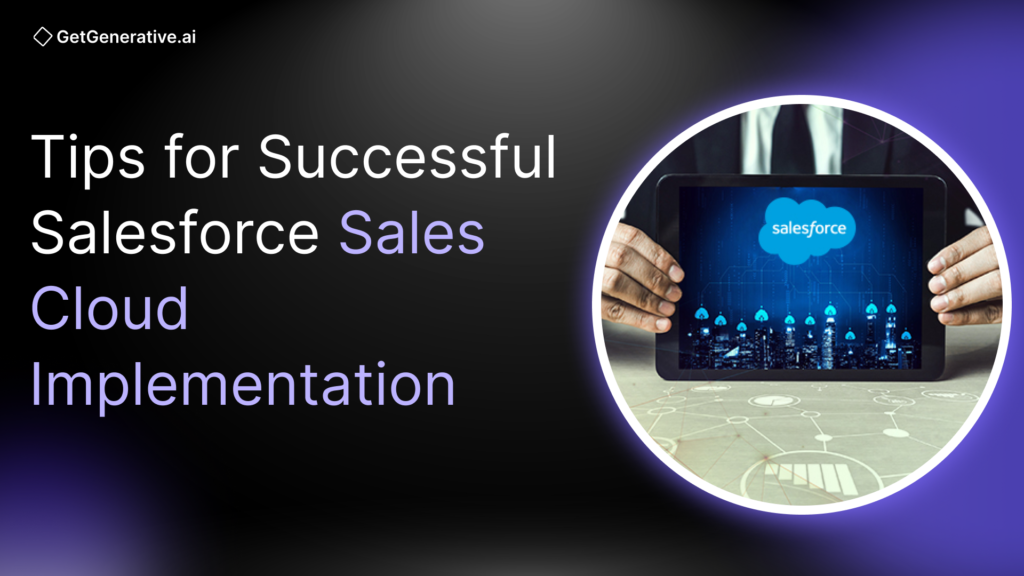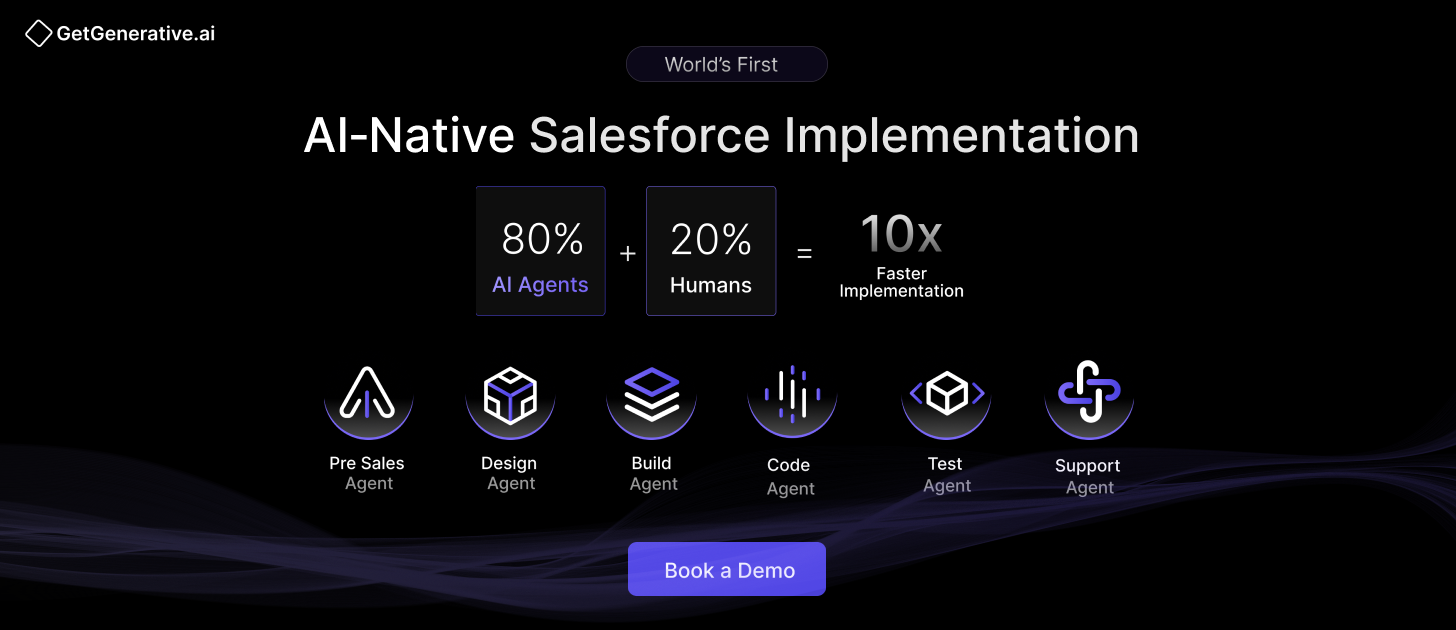Tips for Successful Salesforce Sales Cloud Implementation
Customers report an average 37% increase in revenue after implementing Sales Cloud. But despite this potential, the road to success isn’t guaranteed. Industry data reveals that nearly 70% of CRM initiatives fail to meet their intended goals.
Why do so many Salesforce implementations fall short?
The answer often lies not in the technology itself, but in how it’s deployed—lack of alignment, poor planning, insufficient training, and weak data practices are all culprits. The cost of failure is high, leading to productivity losses, user frustration, and wasted investment.
This guide provides 8 expert-backed tips for achieving success with Salesforce Sales Cloud implementation.
1. Establish a Clear Vision and Cross-Functional Alignment
CRM projects often fail because they are seen as “just another IT rollout.” In reality, Sales Cloud is a business transformation initiative that must be approached with a strategic mindset.
What to Do:
Set measurable business goals. Define what success looks like—e.g., “20% increase in lead conversion within 12 months” or “30% improvement in forecast accuracy.” These KPIs will guide configuration decisions and keep teams aligned.
Secure executive sponsorship. Assign a senior leader who can champion the initiative, secure funding, and align it with broader transformation objectives.
Form a steering committee. Include stakeholders from Sales, Marketing, Operations, and IT. This group should manage prioritization, resolve conflicts, and ensure that end-user needs are represented.
Integrate with broader transformation goals. Sync the CRM rollout with other ongoing digital initiatives (like customer service revamps or data governance programs) to create a unified tech strategy.
2. Invest in Realistic Scoping and Robust Planning
One of the biggest pitfalls is underestimating the scope and complexity of Salesforce implementations. A Forrester study found 41% of CRM projects exceed their budgets, often due to hidden data migration challenges, unclear requirements, or unrealistic timelines.
What to Do:
Conduct a detailed requirements analysis. Involve business users early to capture real pain points and avoid building features that won’t be used. Gartner reports that 45% of software features go unused, often because they weren’t needed in the first place.
Phase your implementation. Break the project into manageable stages (e.g., Phase 1: Accounts/Opportunities, Phase 2: Integrations, Phase 3: Analytics). This allows for quick wins, course correction, and gradual adoption.
Budget beyond licenses. Account for training, data work, integration, change management, and post-go-live support. Experts recommend allocating 20–25% of the total budget to data and integration efforts alone.
Use proven PMO practices. Leverage Agile or hybrid project management models with clear milestones, risk management, and stakeholder checkpoints.
3. Clean Your Data and Plan for Seamless Integration
Salesforce thrives on clean, reliable data. Poor-quality data is a leading reason for user mistrust and adoption failure. According to Experian, only 36% of data migration projects stay within budget, and over 50% are delayed due to unexpected data issues.
What to Do:
Audit and cleanse data early. Identify and eliminate duplicates, outdated contacts, and inconsistent formats. Involve business SMEs to validate accuracy.
Establish data governance. Set validation rules, required fields, and duplicate management logic. Assign ownership to data stewards for continuous quality assurance.
Integrate wisely. Prioritize which systems need real-time vs. batch integrations (e.g., ERP, CPQ, marketing tools). Use middleware like MuleSoft or Boomi where needed.
Automate data flows. Leverage Salesforce-native tools (e.g., Web-to-Lead, Data Loader) or scalable ETL pipelines for regular updates.
Test thoroughly. Simulate live workflows—e.g., an opportunity originating in Salesforce and syncing to ERP—to verify data accuracy across systems.
4. Configure First, Customize Cautiously
Sales Cloud is one of the most configurable platforms on the market. But this power often leads to over-customization, which can increase technical debt, break during Salesforce updates, and slow down adoption.
What to Do:
Start with standard objects and automation tools. Leverage built-in tools like Flows, Lightning App Builder, and validation rules before turning to code.
Avoid unnecessary custom code. Use Apex or custom components only when truly required—and only with a business case.
Document customizations. Maintain an internal “change log” and org documentation to reduce future confusion.
Review technical debt periodically. Use Salesforce Optimizer and do regular org health checks to clean up unused fields, workflows, and code.
Establish governance. Form a configuration review board to evaluate change requests and enforce standards.
Also Read – Top Salesforce Sales Cloud Implementation Partners
5. Prioritize User Training and Change Management
Even the most technically sound Salesforce Sales Cloud implementation can fail if users don’t adopt it. Studies show that over 60% of CRM failures are due to people-related factors, such as inadequate training, poor communication, or lack of perceived value. A system only delivers ROI when it’s actively used.
What to Do:
Engage users early. Involve sales reps in requirement gathering and testing to create system champions and build early buy-in.
Clarify “What’s in it for me?” Show reps how Salesforce helps them close more deals, automate tasks, and simplify forecasting. When users see personal value, adoption skyrockets.
Deliver role-based training. Design training by role (e.g., sales reps vs. managers vs. operations staff). Use a mix of classroom, video, and hands-on sandbox sessions.
Create internal champions. Designate “super users” across regions or teams who can mentor peers and provide first-line support post-launch.
Use in-app guidance. Leverage Salesforce’s Walkthroughs, Help Menus, and Trailhead to offer on-demand learning and embedded instructions.
Track adoption metrics. Use Salesforce dashboards to monitor login frequency, record updates, and pipeline activity. This data can identify coaching opportunities or training gaps.
Gamify and reward. Recognize teams with high CRM hygiene, data completeness, or usage rates. Incentives can drive engagement in the early months.
6. Test Rigorously and Pilot Before Full Rollout
One of the most overlooked steps in a Salesforce implementation is robust testing. But cutting corners during testing is a high-risk gamble. Issues like permission gaps, broken workflows, or slow-loading pages erode trust fast, and recovering that trust is difficult.
What to Do:
Create comprehensive test cases. Validate all user flows—lead conversion, opportunity stages, forecasting, reporting, etc.—across user roles.
Run User Acceptance Testing (UAT). Involve real end-users to simulate day-to-day scenarios. Their feedback will uncover usability gaps the project team may miss.
Pilot the system with a small group. A limited rollout (by region or team) reduces risk. Gather real-world feedback before expanding to the broader org.
Test data and performance at scale. Run reports, check data volume performance, and validate dashboards under load conditions. Salesforce governor limits can affect poorly optimized code and queries.
Verify security settings. Test different profiles and roles to ensure access is properly restricted and compliant with internal policies.
7. Establish Strong Governance, Security, and Compliance Practices
Salesforce often becomes the system of record for customer, deal, and revenue data. That makes security, compliance, and ongoing governance non-negotiable—especially in regulated industries like healthcare, financial services, and government.
What to Do:
Define access roles and data classifications. Use Salesforce’s role hierarchy and sharing rules to enforce least-privilege access. Sensitive fields (e.g., pricing, margin) should be locked down.
Implement audit trails and monitoring. Use Field History Tracking and, for sensitive systems, Salesforce Shield’s Event Monitoring to detect anomalies.
Enable MFA and field-level security. MFA is now required for all Salesforce users. Apply encryption where necessary and mask fields with PII.
Work with legal/compliance teams. Ensure processes meet requirements under GDPR, HIPAA, SOX, or other relevant frameworks. This includes right-to-erasure, consent tracking, and data retention.
Review permissions quarterly. Implement a formal access review process. Users often accumulate access over time—regular cleanups help minimize risk.
Control app installations and sandbox refreshes. Limit who can install AppExchange packages and who has access to full sandboxes, which may include real data.
8. Monitor, Iterate, and Continuously Optimize
A CRM is not a “set it and forget it” system. Organizations that treat Salesforce as a living, evolving platform are the ones that realize long-term strategic value and competitive advantage.
What to Do:
Monitor KPIs and usage metrics. Track outcomes like lead-to-close rates, sales velocity, quota attainment, and CRM usage by rep or region. Identify what’s working and where friction remains.
Establish a Center of Excellence (CoE). Whether internal or external, a CoE can manage enhancements, user requests, roadmap planning, and governance.
Review Salesforce release notes. Salesforce delivers 3 major updates per year—new features may help you replace legacy customizations or automate previously manual tasks.
Solicit ongoing user feedback. Regular surveys or feedback sessions ensure that enhancements are driven by real needs, not assumptions.
Adopt agile sprints post-go-live. Continue to improve Salesforce in small, iterative steps—adding fields, automating reports, or refining processes.
Celebrate success and share impact. Publicize wins—e.g., “Sales cycle reduced by 22%,” “Revenue per rep up 18%.” Success stories build confidence and help institutionalize adoption.
Related Read – Top Challenges in Salesforce Sales Cloud Implementation
Conclusion
Salesforce Sales Cloud isn’t just a CRM—it’s a strategic platform for customer growth, sales execution, and operational visibility. But realizing this potential requires deliberate leadership, rigorous planning, user-focused design, and ongoing optimization.
At GetGenerative.ai, we’ve reimagined Salesforce implementation—built from the ground up with AI at the core. This isn’t legacy delivery with AI added on. It’s a faster, smarter, AI-native approach powered by our proprietary platform.
👉 Explore our Salesforce AI consulting services
FAQs
1. How long does it take to implement Salesforce Sales Cloud?
The time required for implementation depends on the complexity of your business needs. For most organizations, the process takes an average of 2–4 months.
2. Can small businesses benefit from Salesforce Sales Cloud?
Yes, without a doubt! Salesforce Sales Cloud is designed to be flexible and scalable, making it an excellent fit for businesses of any size.
3. What is the biggest challenge in implementing Sales Cloud?
The most common challenges are data migration issues and user adoption. Proper planning and training can address these effectively.
4. Do I need an IT team for Salesforce Sales Cloud implementation?
While having an IT team is helpful, small businesses can leverage Salesforce’s tools and certified partners to manage implementation.
5. How do I measure the success of my implementation?
Track KPIs like lead conversion rates, sales pipeline progress, and user adoption to evaluate the impact of your implementation.




